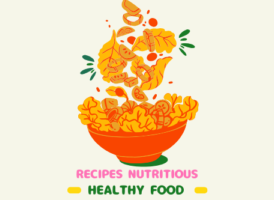Spring’s fresh produce beckons, but kitchen time often feels limited. The season brings asparagus, peas, and rhubarb to our tables, yet busy schedules rarely allow extended cooking time.
These spring dinner recipes turn seasonal vegetables into mouthwatering meals within 30 minutes. Winter demanded hearty, slow-cooked dishes, but spring meals shine with simplicity and speed. Simple preparations of artichokes and fresh herbs prove that quick cooking preserves flavor beautifully.
Our kitchen-tested collection of 15 spring dinner recipes maximizes seasonal ingredients efficiently. Each dish pairs spring vegetables with chicken, salmon, or pork to create balanced meals your family will enjoy. The recipes keep you away from the stove and closer to the dinner table.
Table of Contents
Lemon Garlic Chicken with Spring Vegetables
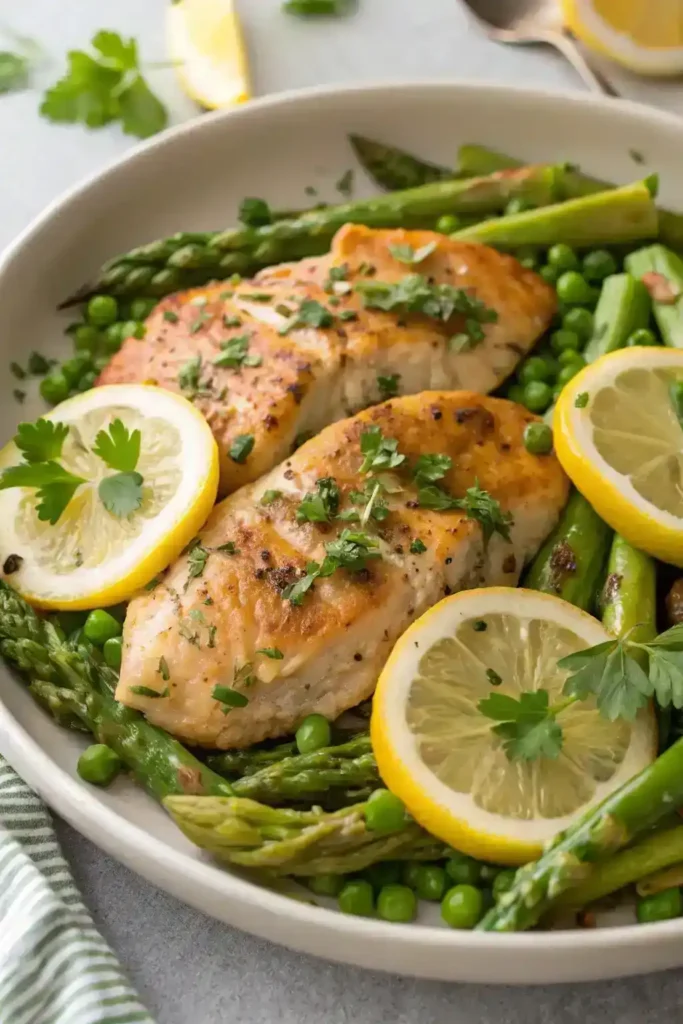
This vibrant lemon garlic chicken dish will change your spring dinner routine by bringing seasonal vegetables together in perfect harmony.
Key Spring Ingredients in This Dish
Fresh asparagus spears steal the show with fingerling potatoes and grape tomatoes. The dish combines zesty minced garlic cloves, fresh lemon juice, and aromatic herbs to create a light, refreshing sauce. Cremini mushrooms bring an earthy depth that pairs beautifully with the bright spring flavors.
Preparation and Cooking Tips
Your oven should be preheated to 475°F to get the best results. Start by flattening the chicken breasts so they cook evenly. Mix olive oil, minced garlic, lemon zest, and fresh herbs to create a flavorful marinade. The vegetables need simple prep – trim the asparagus and cut the tomatoes in half before mixing them with olive oil and garlic.
Success depends on timing. The potatoes need about 20 minutes to become tender. The marinated chicken and asparagus should go in the pan after that. You’ll have dinner ready in about 30 minutes, which makes this perfect for busy weeknight spring meals.
Serving Suggestions
A bed of fresh arugula makes the perfect base and adds a seasonal touch. The dish tastes even better with crumbled feta cheese, fresh parsley, and dill on top. Quinoa, farro, or brown rice work great to soak up all the tasty pan juices and make the meal complete.
Nutritional Benefits
This balanced spring dinner packs impressive nutritional value. Each serving has about 306 calories and 30g of protein to help maintain muscle. The dish also provides key nutrients including Vitamin A (657IU), Vitamin C (11mg), and calcium (70mg). Lean protein combined with fresh vegetables creates a filling meal that’s packed with nutrients.
One-Pan Salmon with Asparagus and Dill
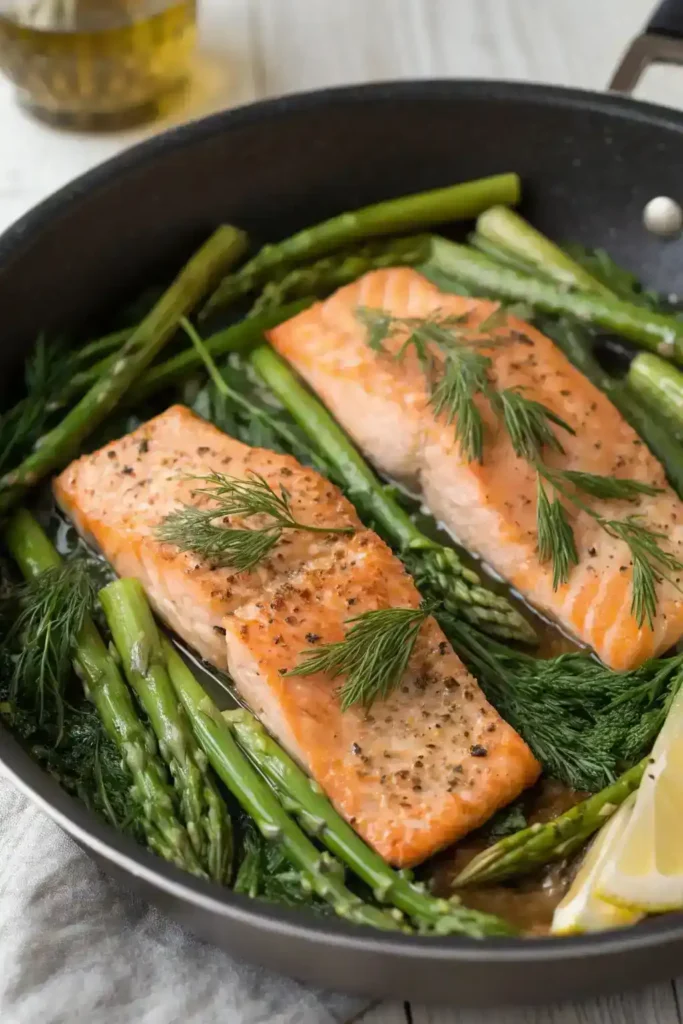
Lift your spring dinner menu with this elegant one-pan salmon dish that pairs tender asparagus with aromatic dill.
Why This Spring Dinner Works in 30 Minutes
This quick spring dinner works because of its smart cooking method. The salmon and asparagus cook together at 400°F. You won’t overcook either ingredient. Everything comes together on a single baking sheet which means less cleanup. The dish keeps its gourmet appeal with a special lemon-garlic-herb butter that melts perfectly over both the fish and vegetables.
Step-by-Step Cooking Process
Pat the salmon dry and place it in the center of a parchment-lined baking sheet. Place trimmed asparagus spears around the salmon. Mix softened butter, fresh lemon juice, minced garlic, and chopped dill to create the signature sauce. Brush most of this flavorful mixture over the salmon and spread the rest on the asparagus.
The best results come from baking uncovered at 450°F for 10-12 minutes, based on your filet’s thickness. Switch to broil for 2-3 minutes at the end to get that perfect golden finish.
Flavor Variations
The classic combination tastes great, but you can definitely try different flavors. Here’s what you might like:
- A honey-dijon glaze adds subtle sweetness and complements the salmon’s natural richness
- White wine in the sauce creates a restaurant-style finish
- Fresh herbs like tarragon or chives work well with dill for complex herbal notes
- Pistachios and fresh peas in spring pesto add interesting texture
You can swap the butter-based sauce with a coconut milk version if you want dairy-free options while keeping the creamy texture. A light citrus sauce using orange juice and zest makes a bright spring flavor too.
Spring Vegetable Pasta Primavera

Become skilled at making pasta primavera, a delightful spring dinner that shows off the season’s freshest vegetables in a light, flavorful sauce.
Selecting the Best Spring Vegetables
The best pasta primavera needs vegetables at their peak freshness. English peas, fava beans, and asparagus are the traditional spring foundations. In spite of that, you can add zucchini, yellow squash, and cherry tomatoes to bring more color and texture. The vegetables should be cut into similar sizes to cook evenly – pieces should be 1/2 to 1-inch.
Quick Pasta Cooking Techniques
The water should be generously salted until it “tastes like the sea”. Short pasta shapes like penne, fusilli, or orecchiette work better than long noodles. The pasta needs to cook until just al dente, usually 8-10 minutes. A significant tip: save 1 cup of pasta cooking water before draining – this starchy liquid creates the perfect sauce.
Making the Perfect Primavera Sauce
Simple ingredients make an exceptional primavera sauce. Crème fraîche brings a brighter flavor than heavy cream and works better with spring vegetables. Start by letting butter absorb garlic flavors – smash whole cloves and cook them gently in butter, then remove them before mixing with other ingredients.
Mix these ingredients to create the signature sauce:
- Infused garlic butter
- Reserved pasta water
- Crème fraîche
- Fresh lemon zest and juice
- Grated Parmigiano-Reggiano
Mix the cooked pasta with blanched vegetables in the sauce and add pasta water slowly until it becomes silky. You should see a creamy trail when dragging a spoon through the sauce-coated pasta. Fresh herbs like basil and tarragon add the final aromatic touch to this spring dish.
15-Minute Shrimp and Pea Risotto
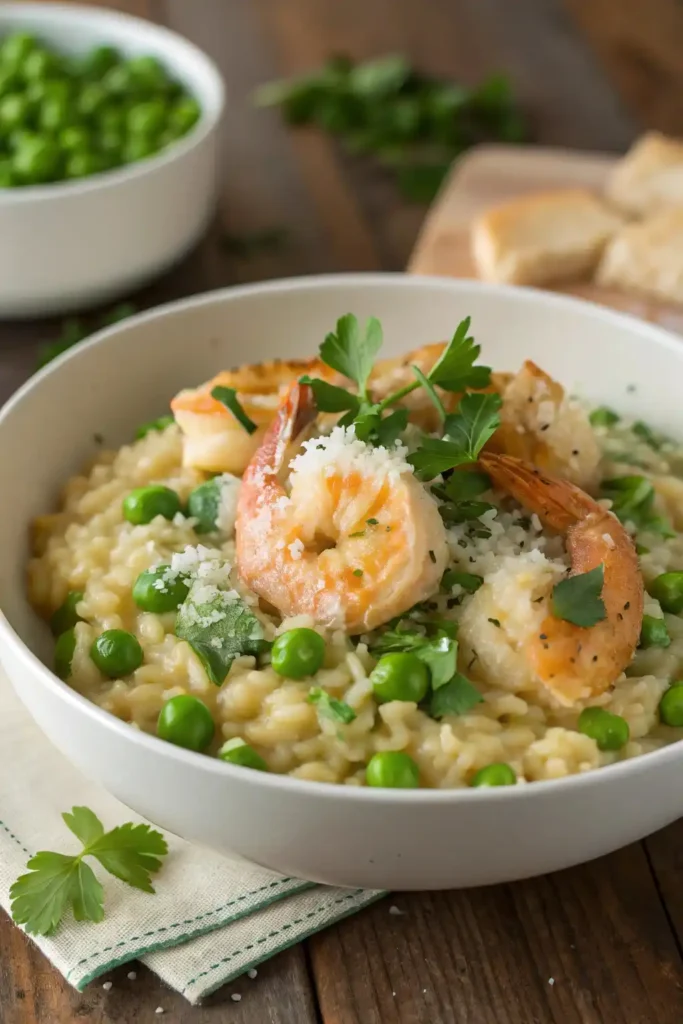
You can make restaurant-quality risotto in just 15 minutes with plump shrimp and sweet spring peas.
Shortcuts for Quick Risotto
The quickest way to make risotto starts with good preparation. Keep the broth hot and simmering while you cook. Arborio or carnaroli rice will give you the creamiest texture since these short-grain varieties release their starches during cooking.
Golden sautéed shallots create the base, then toast the rice until it turns translucent – about 1-2 minutes. White wine goes in next and should evaporate completely. The real time-saving magic happens when you add hot broth in 1/2 cup portions. Stir constantly until each portion absorbs. This technique will give you perfect creamy risotto without endless stirring.
Shrimp Cooking Tips
Medium to large shrimp, peeled and deveined, work best for this dish. The olive oil should shimmer before adding shrimp – this temperature gives you the perfect sear. The shrimp need just 3-4 minutes until they turn pink and opaque. Watch them carefully since overcooked shrimp become tough and rubbery.
Fresh vs. Frozen Peas Debate
Fresh and frozen peas taste equally delicious in this spring dinner. Steam fresh peas for two minutes before adding them to your risotto. Frozen peas make a great alternative since they’re packed at peak freshness with minimal prep needed. A quick 30-second microwave thaw gets frozen peas ready to use.
Your risotto should flow like waves – what Italians call “all’onda”. Add the peas in the final minutes along with butter and fresh Parmesan. This timing keeps the peas bright and sweet while your risotto develops its signature creamy finish.
Herb-Crusted Pork Tenderloin with Radish Salad
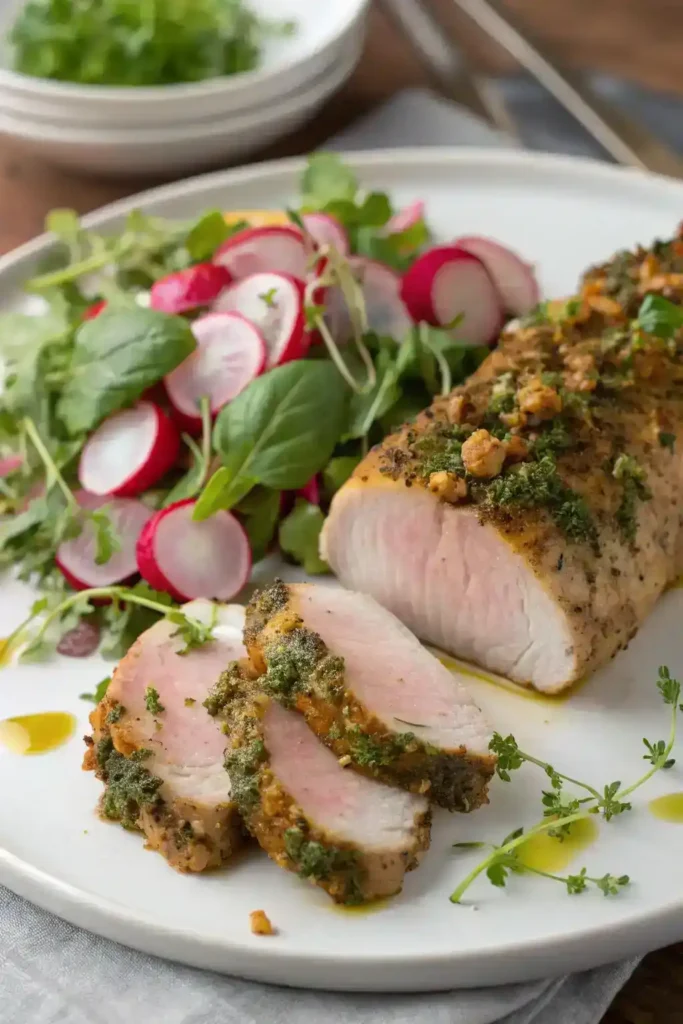
Bring spring flavors to your table with this perfectly seasoned pork tenderloin and a crisp radish salad.
Pork Tenderloin: The Quick-Cooking Cut
Pork tenderloin makes a great choice for quick spring meals and cooks to perfection in just 25-30 minutes. Your oven should be at 425°F before you sear the meat until it’s golden brown on all sides. The meat’s internal temperature needs to reach between 145°F and 150°F to stay juicy and tender. This lean cut gives you 48g of protein per serving with only 335 calories.
Spring Radish Selection and Preparation
Look for firm, smooth radishes without any cracks. Young spring radishes taste best when they’re less than 1 inch across. The salad needs thinly sliced radishes mixed with fresh arugula or lamb’s lettuce. These little red gems pack lots of potassium, vitamin C, folate, and fiber. Their crisp texture and peppery kick work beautifully with the tender pork.
Herb Combinations That Raise This Spring Dish
Mix fresh parsley, thyme, and rosemary to create a tasty herb crust. Start by blending chopped herbs with soft butter and breadcrumbs. Spread this fragrant mixture all over the pork before it goes in the oven. A bit of Dijon mustard in the herb crust adds an extra punch of flavor.
The dish comes together perfectly with a bright salad dressed in white balsamic vinegar, lemon juice, and olive oil. This spring dinner balances protein and fresh vegetables nicely for health-conscious eaters. The herb-crusted exterior gives way to juicy meat inside, while the radish salad adds a fresh crunch in every bite.
Spring Minestrone with Fresh Herbs
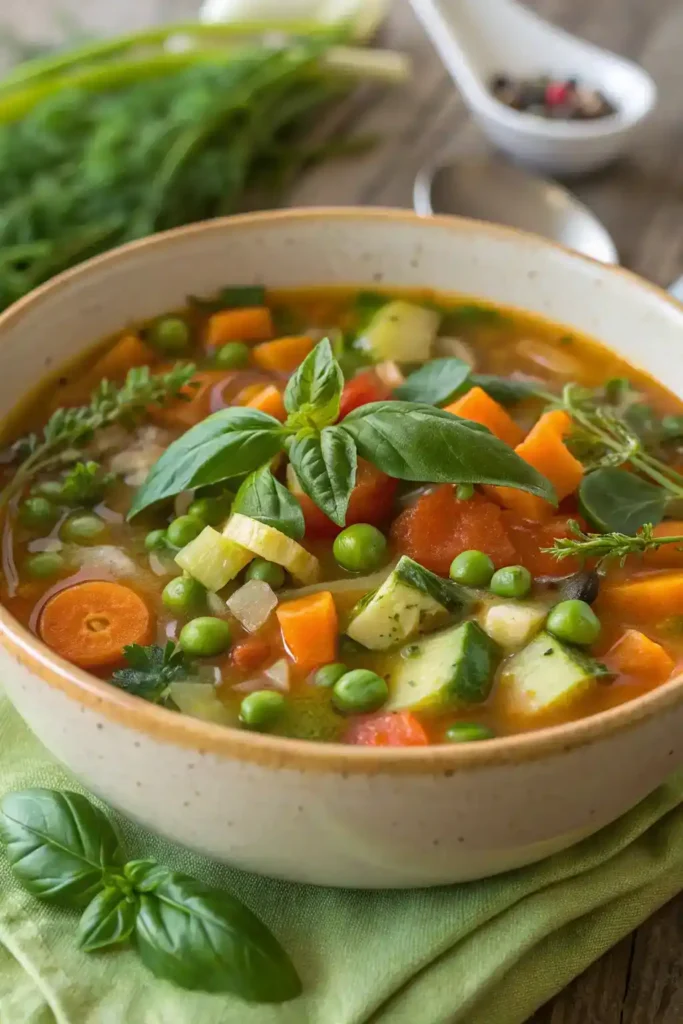
Welcome spring with this flexible minestrone soup that showcases seasonal produce and fresh herbs.
Seasonal Vegetables for Spring Minestrone
Fresh asparagus, peas, fennel, and broccoli give this soup its beautiful green color. Your soup will taste best with vegetables at peak freshness. Leeks make a subtle substitute for onions, and fresh artichoke hearts bring that special springtime feel. The soup’s foundations include classic ingredients like onions, carrots, and celery.
Time-Saving Soup Techniques
Start by sautéing aromatics in olive oil over medium-high heat. The vegetables should soften before you add garlic and thyme. Let these cook 2-3 minutes more. A Parmesan rind during simmering will improve your soup’s flavor. You’ll have dinner ready in about 45 minutes – perfect for busy spring evenings.
Herb Combinations for Maximum Flavor
Fresh herbs will revolutionize this spring minestrone. Mix fresh basil, parsley, and dill to create bright flavors. Ligurian cooks swear by fresh herbs for seasoning, while northern regions love their Parmesan rinds for depth. Fresh rosemary or tarragon can create exciting variations.
Serving and Storage Tips
Your soup will stay fresh up to 5 days in an airtight container in the fridge. Cook pasta separately and add it right before serving for the best texture. Heat leftovers gently on the stovetop over medium-low heat. Make each bowl special with:
- A splash of premium extra virgin olive oil
- Fresh Parmesan shavings
- Fresh herbs sprinkled on top
- Crunchy homemade croutons
This spring minestrone packs impressive nutrition with about 217 calories per cup, including 5.6g fat, 34.5g carbohydrates, and 9.1g protein. Seasonal vegetables and aromatic herbs come together in this light yet filling spring dinner that truly captures the season’s best flavors.
Asparagus and Goat Cheese Frittata

Make your spring dinners easier with this versatile frittata that combines tender asparagus and creamy goat cheese.
Why Frittatas Make Perfect Spring Dinners
This egg-based dish gives you countless ways to use seasonal produce while serving a protein-packed meal. You’ll need just 15-20 minutes to cook it. These versatile dishes taste great straight from the oven, at room temperature, or even cold. Each serving packs impressive nutrition with 378 calories and 26g of protein.
Asparagus Preparation Shortcuts
Thin asparagus spears cook faster and work best. Cut off the tough ends and slice the spears into 1-inch pieces. You can blanch the asparagus in salted water for 1½ minutes until it becomes tender-crisp. Another option is to sauté the pieces in olive oil for 3-5 minutes until tender. Save a few whole spears to place on top of the frittata before baking for an attractive presentation.
Cheese Pairing Options
Creamy goat cheese without rind adds a wonderful tangy flavor. Cut it into ⅓-inch rounds and spread them evenly on top for the best results. Several other cheeses work great too:
- Gruyere adds a nutty depth that pairs well with hearty greens
- Fontina melts beautifully throughout the dish
- Ricotta creates a more delicate, lighter texture
- Feta brings a salty kick that balances the mild eggs perfectly
The perfect frittata needs precise timing. Cook it on the stovetop until the edges set, about 2-3 minutes. Then move it to a 400°F oven and bake for 8-10 minutes until the center sets. Add fresh herbs like chives, parsley, or dill before serving.
Quick Beef Stir-Fry with Snow Peas
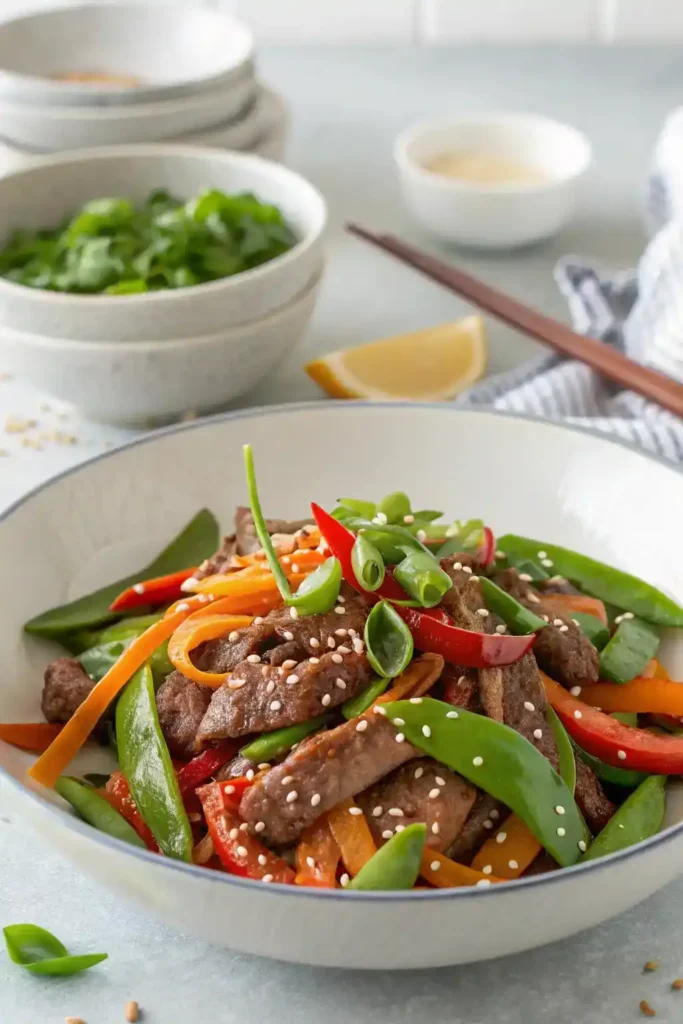
Make a delicious beef and snow pea stir-fry that rivals your favorite Asian restaurant in less than 30 minutes. This springtime meal brings together juicy meat and crunchy vegetables in a flavorful sauce.
Stir-Fry Techniques for Speed
Your success starts with good prep work. Let your wok heat until you see light smoke, which shows it’s reached the right temperature. Spread your marinated beef in one layer and let it sear without touching it for a minute to get that rich brown color. Home cooks should stick to twelve ounces of beef per batch to avoid steaming.
The oil should flow down the wok’s sides naturally to reach the bottom. This method will give a consistent heat and stop food from sticking. Add your garlic and ginger right when the oil starts to smoke.
Snow Pea Preparation
Cut off the tough snow pea ends and pull out the side strings to make them more tender. Your ingredients should be uniform and bite-sized so they cook evenly. A quick stir-fry with garlic will turn snow peas bright green while keeping their snap.
Sauce Variations for Different Flavor Profiles
A basic sauce blends soy sauce, sherry (or cooking wine), cornstarch, and brown sugar. You can create something richer by adding:
- Oyster sauce to boost umami
- Dark soy sauce to deepen color and flavor
- A hint of sesame oil as the final touch
Blend your sauce ingredients in a small bowl until the cornstarch dissolves. The sauce should go around the wok’s edges instead of the middle to keep the heat high and create that prominent “wok hei” flavor.
Your beef should cook just until it loses its pink color before you take it out. The snow peas need a quick stir-fry with garlic to stay crisp. Finally, put the beef back in, add your sauce, and toss everything together quickly.
Lemon Ricotta Gnocchi with Spring Peas
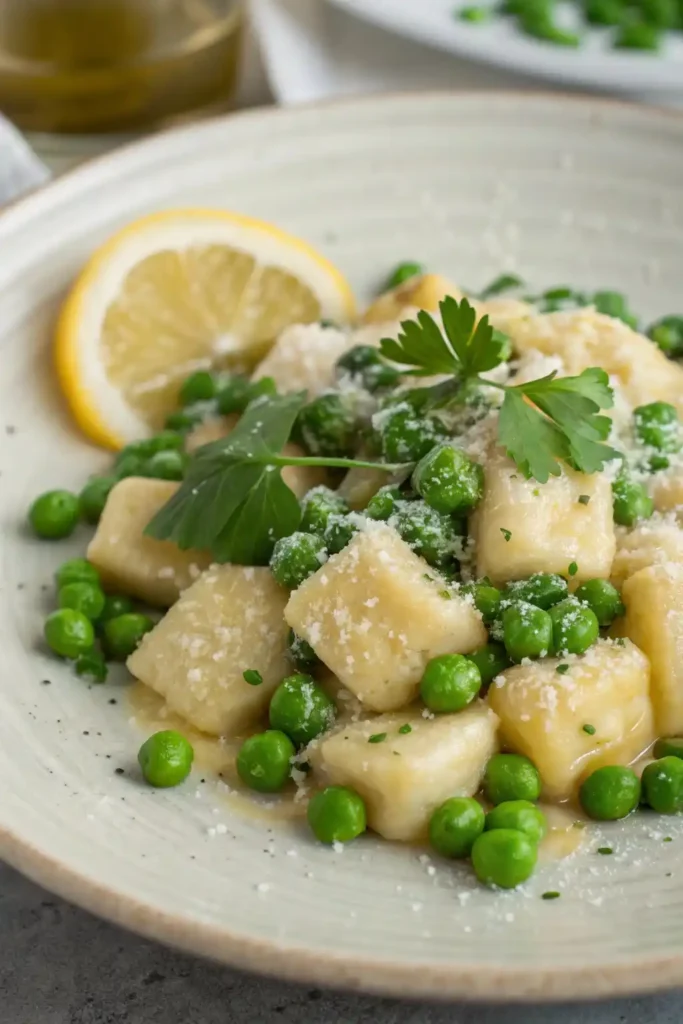
Make a delightful spring dinner with this quick lemon ricotta gnocchi that captures fresh seasonal flavors in every bite.
Store-Bought vs. Homemade Gnocchi
Homemade gnocchi gives you better texture, but store-bought options work great for quick meals. The quality of shelf-stable gnocchi has improved by a lot, making it a reliable pantry staple. You’ll find the best options in vacuum-sealed packages in the pasta aisle. These ready-made versions turn out great when pan-seared, giving you a crispy exterior and tender center.
Creating a Quick Lemon Sauce
A great lemon sauce needs the right technique. Melt butter in a large saucepan over medium heat. Let the minced garlic cook until you smell its aroma. Mix heavy cream, fresh lemon juice, and zest, then let it simmer until the sauce thickens a bit. Vegetable stock and fresh herbs add extra flavor depth.
Adding Spring Vegetables Effectively
Fresh spring peas make this dish special. Thaw frozen peas briefly to keep their bright color. Timing is vital – add peas in the final cooking minutes to keep their sweet flavor. Here are some winning combinations:
- Fresh basil and mint add aromatic depth
- Crumbled Parmesan brings savory notes
- Tender spring herbs like chives or tarragon work beautifully
The magic happens when you sear the gnocchi until golden brown, which takes 7-10 minutes for fresh or frozen varieties. Once you get that crispy exterior, mix it with the lemon cream sauce and peas, coating each piece gently.
This spring dinner brings together convenience and style, turning simple ingredients into an impressive meal in under 30 minutes. Tender gnocchi, bright lemon sauce, and sweet peas create a perfect blend of flavors that shows off the season’s best.
Artichoke and Spinach Stuffed Portobello Mushrooms
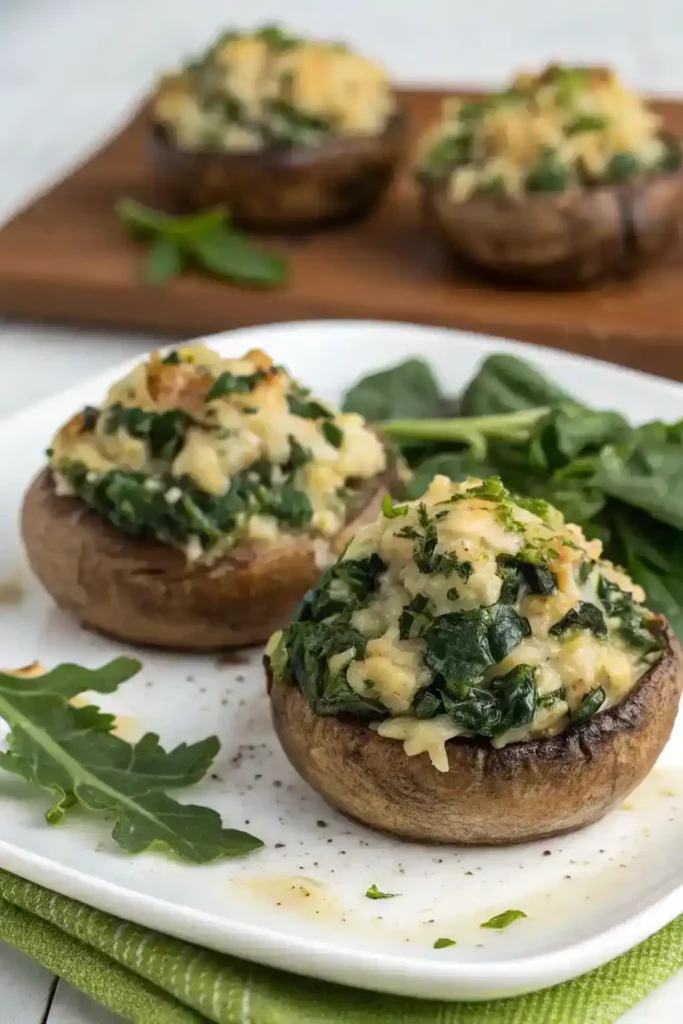
These protein-rich stuffed portobello mushrooms make a stunning spring dinner. The vegetarian stuffing blends spinach and artichokes beautifully.
Preparing Portobello Mushrooms
Your success starts with picking the right mushrooms. Look for firm caps 1½ to 2 inches in diameter that work perfectly for stuffing. Clean the mushrooms with a damp paper towel to wipe away dirt. You’ll get the best results when you remove the stems and scrape out the gills with a spoon. This creates extra room for your filling. The mushrooms will last longer too, since gills tend to spoil first.
Quick Filling Techniques
Great filling makes this dish special. Start by melting butter and sautéing the chopped mushroom stems with onions and garlic until soft. Mix cream cheese, Parmigiano-Reggiano and panko breadcrumbs to add richness and crunch. Sun-dried tomatoes and fresh herbs will improve the flavor profile. Load each cap generously with about 2½ teaspoons of filling to pack every bite with flavor.
Vegetarian Protein Options
This spring meal packs impressive nutrition while staying vegetarian-friendly. Each portion contains 42 calories and 2g of protein. The protein content gets better with these additions:
- TVP adds a meaty bite
- Italian-seasoned crumbled tofu
- Meltable plant-based cheese alternatives
The stuffed mushrooms need 15-20 minutes at 425°F until golden brown on top and tender throughout. You can make the filling two days ahead and keep it sealed tight. These tasty portobellos stay fresh in the fridge for 3-5 days. That makes them perfect for spring meal prep.
Spring Pesto Flatbread Pizza
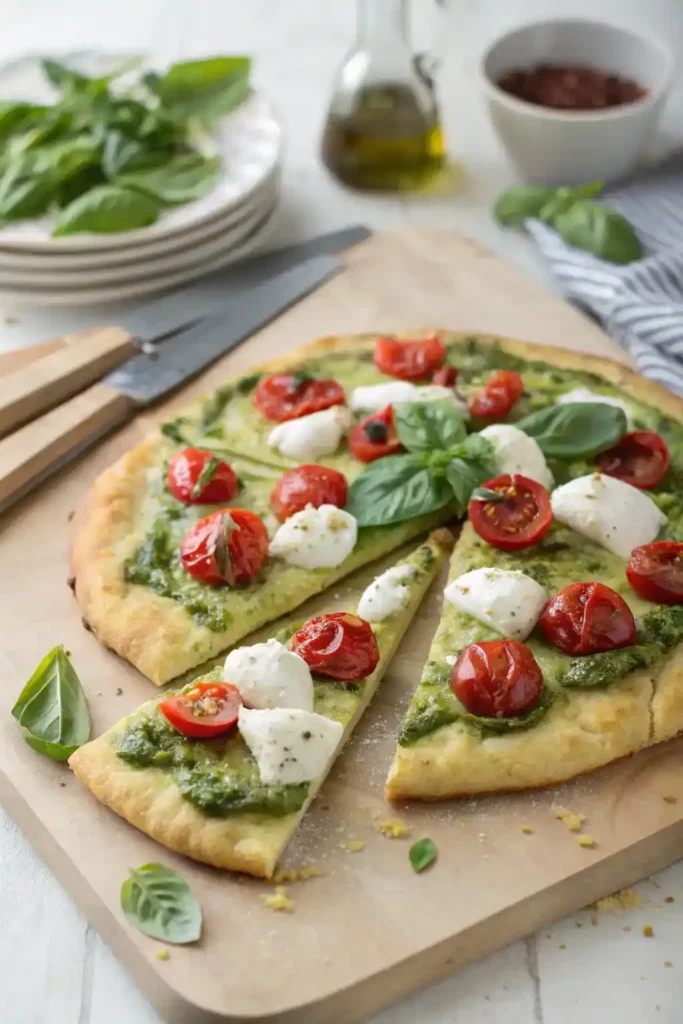
Tap into the full potential of spring ingredients with this quick flatbread pizza that brings seasonal herbs and fresh toppings together.
No-Rise Flatbread Dough
A speedy base comes together with all-purpose flour, baking powder, and salt as core ingredients. The dough takes shape when you mix olive oil and warm water until it becomes soft, and you won’t need any yeast. A quick 30-second knead and shaping into a ball lets the dough rest for 10 minutes. The dough should be rolled thin to about 1/8-inch thickness which gives you the perfect crispy crust.
Spring Pesto Variations
Fresh spinach and pea shoots are the foundations of a vibrant spring pesto. These greens blend beautifully with pine nuts, green onions, and grated Manchego or Parmesan cheese. Fresh basil and mint add layers of seasonal flavor. You might also try blending edamame with basil leaves and walnut pieces to create a protein-rich option.
Topping Combinations for Spring
Your flatbread comes alive with carefully chosen spring ingredients. Start with a ricotta base that sparkles with lemon zest. Here are some seasonal combinations that work perfectly:
- Fresh asparagus spears with caramelized onions and burrata
- Tender pea shoots that pair naturally with spinach and fresh mozzarella
- Sun-dried tomatoes that go together with fresh herbs
The magic happens when you brush the flatbread with olive oil and bake it at 475°F for about 7-8 minutes. The crust should turn golden brown before you add your chosen toppings and return it to the oven for 5-10 more minutes. You’ll know it’s ready when the base turns crispy and supports your spring vegetables and melted cheese perfectly.
This spring dinner adapts easily to different dietary needs. Plant-based alternatives work well instead of traditional cheese if you want a dairy-free version. A final drizzle of high-quality olive oil and scattered fresh herbs lets those seasonal ingredients shine in every bite.
Lemony Tuna and White Bean Salad
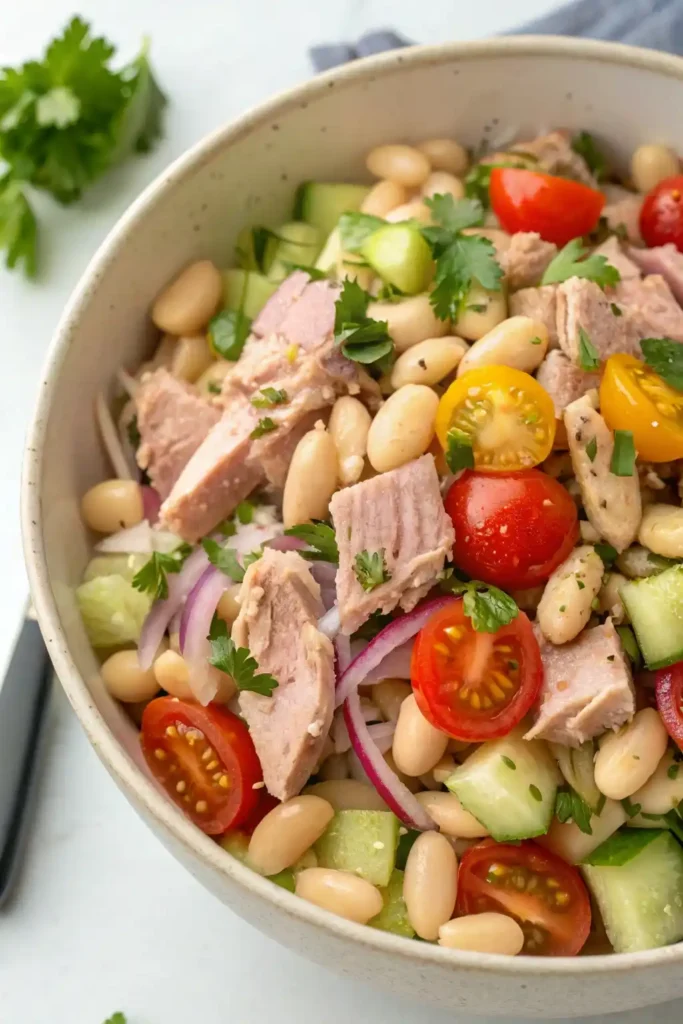
Give your spring dinner menu a refresh with this protein-packed tuna and white bean salad that brings together pantry basics and fresh seasonal ingredients.
Pantry Ingredients That Shine
Quality canned tuna serves as the foundation of this quick spring meal. Wild albacore tuna packed in water packs about 26 grams of protein per can. The cannellini beans are a great match that add protein and fiber and create a creamy texture. You should drain and rinse the beans well before mixing them with other ingredients.
Adding Fresh Spring Elements
Fresh herbs take this simple salad to the next level. Mix parsley, mint, and chives to add bright spring flavors. Red onions bring a zesty crunch – a quick soak in ice water will soften their sharp bite. This method helps the onions blend with the mild tuna and beans instead of overwhelming them.
Dressing That Brings It All Together
A vibrant dressing comes together by whisking fresh lemon juice, extra virgin olive oil, and Dijon mustard. Your dressing should blend into a smooth mix that evenly coats everything. The bean liquid naturally helps the vinaigrette come together better and adds more flavor.
The salad stays fresh in an airtight container for 3-4 days. This makes it perfect for spring meal prep. Each serving packs great nutrition with about 524 calories, 21g of fat, 57g of carbohydrates, and 29g of protein.
Some great additions to try:
- Mixed spring greens as a base
- Crunchy cucumber slices
- Fresh mint leaves on top
This flexible spring dinner works great as a light lunch or dinner. Protein-rich tuna, hearty beans, and a zesty dressing come together in a balanced dish that’s both convenient and tasty.
Rhubarb and Chicken Skillet
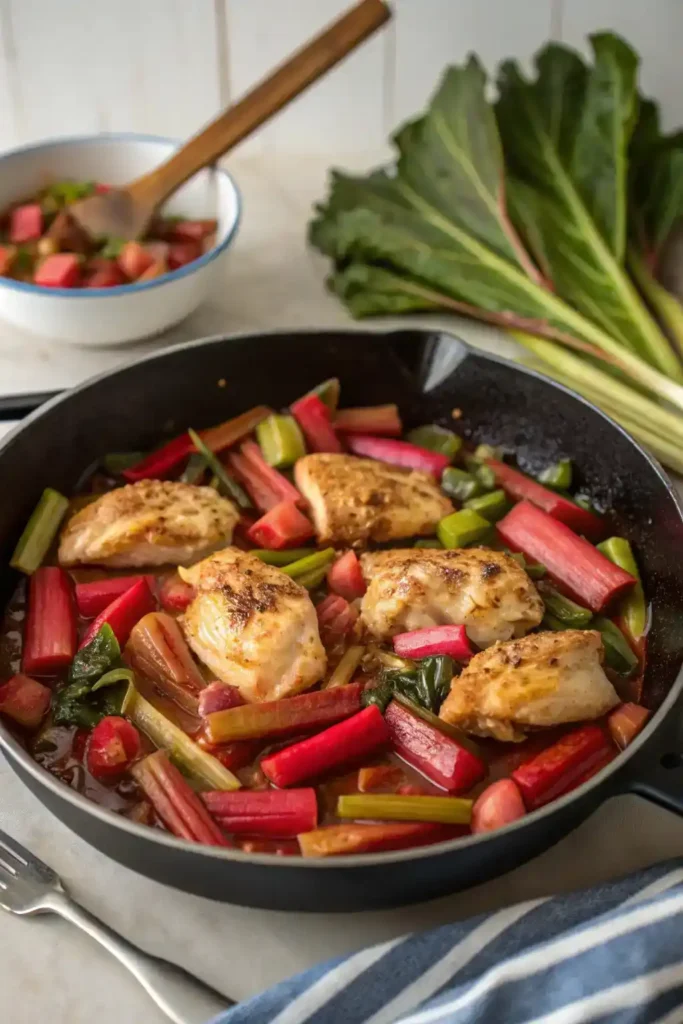
This delightful chicken skillet brings together sweet and tart flavors that highlight spring’s star vegetable – rhubarb.
Working with Seasonal Rhubarb
Bright pink, firm rhubarb stalks will give you the best results. The season brings two main varieties: forced rhubarb from January to March, and maincrop rhubarb from March to June. You’ll notice forced rhubarb’s gentle pink color, while maincrop shows deeper red shades with green leaves. A paring knife helps remove stringy ribs from maincrop rhubarb, but forced rhubarb usually doesn’t need peeling.
One-Pan Cooking Method
Start by searing the chicken until it turns golden brown – this takes about 10 minutes. Move the chicken to a plate once done. The same pan works perfectly to soften spring onions for about 5 minutes. Add garlic and thyme and cook for a minute before the white wine goes in. Your sauce will develop rich flavors as rhubarb, honey, and butter simmer together.
Sweet and Savory Balance
The secret lies in balancing rhubarb’s tartness with savory elements. Three tablespoons of honey makes a good starting point – you can adjust to taste. Watch as rhubarb melts into a silky sauce that pairs beautifully with the chicken. The dish becomes even better with:
- White wine to deglaze
- Fresh thyme sprigs to add aroma
- Butter to create richness and shine
The dish takes 25-35 minutes to cook, depending on your chicken’s size. Spooning pan juices over the chicken near the end creates a beautiful gloss and keeps the meat juicy. The final result brings together sweet, tart, and savory flavors that represent spring’s best offerings.
Spring Vegetable Coconut Curry
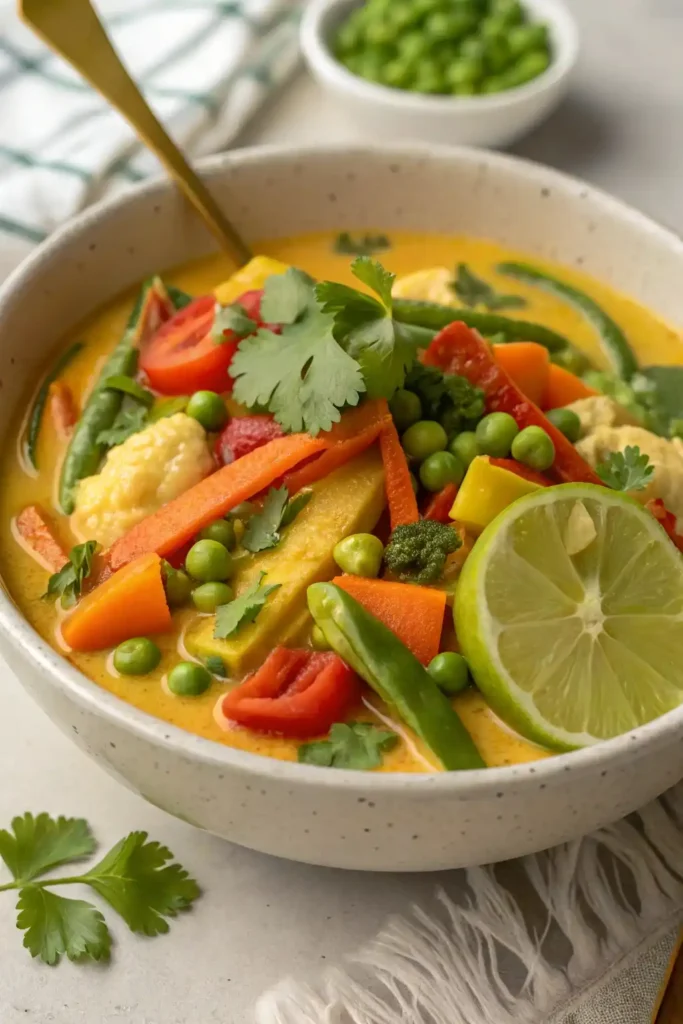
Experience the delicious mix of coconut and curry spices in this quick spring dinner that turns seasonal vegetables into an unforgettable meal.
Quick Curry Base Secrets
This spring curry’s magic starts with its aromatic base. Heat coconut oil and cook finely chopped onions until they turn golden. The authentic flavors come from garlic, ginger, and curry powder that bloom in the oil. Full-fat coconut milk creates the silky sauce that keeps the dish light and perfect for spring.
Spring Vegetables That Work Well
Fresh spring produce takes this curry to new heights. Add 2-inch asparagus pieces near the end to keep them crispy. Sweet potato cubes add substance among cauliflower florets. Bell peppers and snow peas need just a few minutes of cooking time at the end.
Serving Options
This colorful curry tastes amazing over fragrant jasmine rice or brown rice. You can also try quinoa or cauliflower rice if you want something lighter. Make it even better with:
- Fresh lime wedges for brightness
- Chopped cilantro or Thai basil
- A sprinkle of red pepper flakes for heat
The curry comes together in 20-25 minutes. Let it simmer until the vegetables become tender-crisp for the best flavor. The sauce should wrap each vegetable in a perfect blend of coconut richness and aromatic spices. This versatile spring dinner fits many dietary needs and contains approximately 306 calories per serving.
Garlic Butter Scallops with Spring Greens
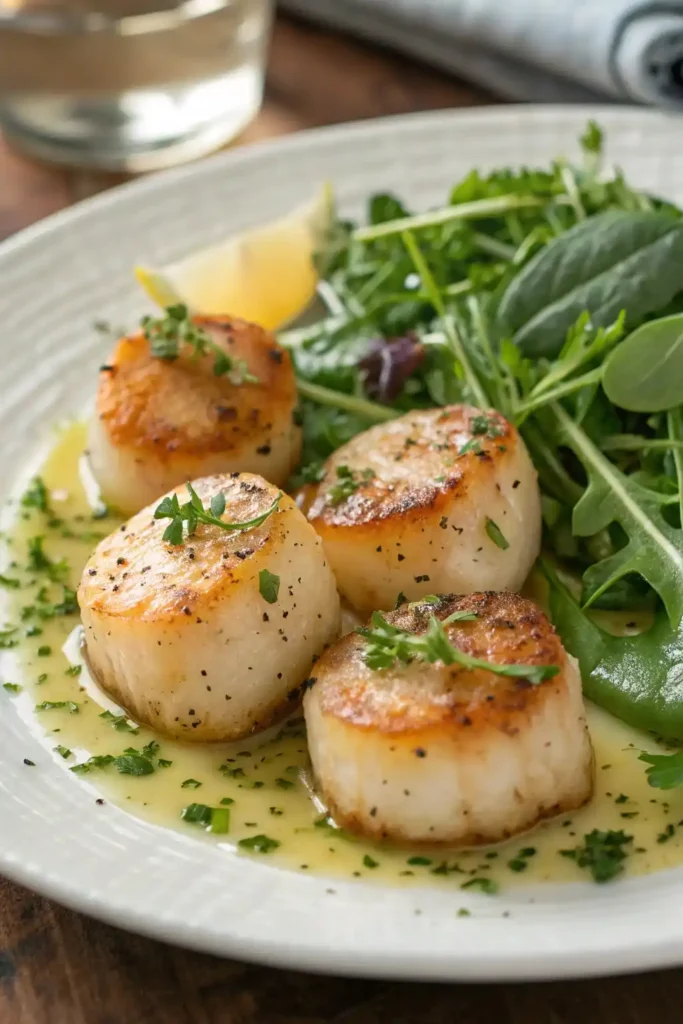
Make a delicious spring dinner in under 30 minutes by pairing perfectly seared scallops with fresh spring greens.
Perfectly Searing Scallops
Dry scallops work better than wet ones to create a beautiful golden crust. Take paper towels and pat the scallops until they’re completely dry. Remove the small side muscle if it’s still attached. Get a stainless steel or cast-iron skillet hot enough to see wisps of smoke. The scallops need about 2 minutes on each side to develop a golden crust. Your scallops will taste perfect when they reach an internal temperature of 115°F.
Spring Greens Selection
A mix of seasonal greens makes the perfect bed for your scallops. Baby arugula adds a peppery kick, and fresh spinach brings a tender texture. You might want to add dandelion greens and pea shoots to get more flavor and nutrients. These spring greens stay bright and crisp after a quick wilt in the pan with garlic and olive oil.
Simple Butter Sauce Techniques
The magic happens when you mix unsalted butter with minced garlic and fresh herbs. Your sauce will be ready in 30 seconds once the garlic releases its aroma. The flavors get better when you add:
- Fresh lemon juice for brightness
- Capers for briny depth
- White wine for complexity
The dish comes together naturally as you baste the scallops with butter sauce in their final cooking moments. This step helps each scallop soak up the rich flavors while keeping its crispy exterior. Put the scallops on the plate right away and spoon the remaining sauce over the wilted greens. Each serving has about 384 calories and gives you a good mix of protein and vegetables.
Comparison Table
| Recipe Name | Main Ingredients | Cooking Time | Calories per Serving | Key Techniques | Serving Suggestions |
|---|---|---|---|---|---|
| Lemon Garlic Chicken with Spring Vegetables | Chicken breast, asparagus, fingerling potatoes, grape tomatoes | 30 minutes | 306 | Roast at 475°F, flatten chicken breasts | Serve on arugula with feta cheese |
| One-Pan Salmon with Asparagus and Dill | Salmon, asparagus, dill, lemon | 12-15 minutes | Not mentioned | Bake at 450°F, finish under broiler | Top with lemon-garlic-herb butter |
| Spring Vegetable Pasta Primavera | Penne/fusilli, English peas, fava beans, asparagus | 8-10 minutes (pasta) | Not mentioned | Cook pasta al dente, save pasta water | Add fresh herbs and Parmigiano-Reggiano |
| 15-Minute Shrimp and Pea Risotto | Arborio rice, shrimp, peas, shallots | 15 minutes | Not mentioned | Add broth gradually, stir continuously | Finish with butter and Parmesan |
| Herb-Crusted Pork Tenderloin with Radish Salad | Pork tenderloin, radishes, fresh herbs | 25-30 minutes | 335 | Sear and roast to 145-150°F | Pair with radish and arugula salad |
| Spring Minestrone with Fresh Herbs | Asparagus, peas, fennel, broccoli | 45 minutes | 217 | Sauté aromatics, add Parmesan rind | Drizzle olive oil and fresh herbs |
| Asparagus and Goat Cheese Frittata | Eggs, asparagus, goat cheese | 15-20 minutes | 378 | Cook stovetop then finish in oven | Serve hot or at room temperature |
| Quick Beef Stir-Fry with Snow Peas | Beef, snow peas, garlic, ginger | Under 30 minutes | Not mentioned | Cook in hot wok, sear in single layer | Not mentioned |
| Lemon Ricotta Gnocchi with Spring Peas | Gnocchi, ricotta, peas, lemon | 15-20 minutes | Not mentioned | Sear gnocchi, prepare sauce | Garnish with fresh herbs |
| Artichoke and Spinach Stuffed Portobello Mushrooms | Portobello mushrooms, spinach, artichokes | 15-20 minutes | 42 | Remove gills, stuff mushrooms | Not mentioned |
| Spring Pesto Flatbread Pizza | Flatbread dough, spring pesto, seasonal vegetables | 12-18 minutes | Not mentioned | Bake at 475°F, layer toppings | Finish with olive oil drizzle |
| Lemony Tuna and White Bean Salad | Canned tuna, white beans, herbs | No cooking required | 524 | Rinse beans, soak onions | Serve over mixed spring greens |
| Rhubarb and Chicken Skillet | Chicken, rhubarb, honey | 25-35 minutes | Not mentioned | Sear chicken, create rhubarb sauce | Serve with pan sauce |
| Spring Vegetable Coconut Curry | Spring vegetables, coconut milk, curry spices | 20-25 minutes | 306 | Bloom spices, simmer gently | Serve over jasmine or brown rice |
| Garlic Butter Scallops with Spring Greens | Scallops, spring greens, garlic butter | Under 30 minutes | 384 | Sear on high heat to 115°F | Present with wilted greens and butter sauce |
Conclusion
These 15 spring dinner recipes show you don’t need to spend hours in the kitchen to cook delicious seasonal food. Each dish makes the most of spring’s fresh ingredients and fits perfectly into busy schedules. The zesty Lemon Garlic Chicken with Spring Vegetables and innovative Rhubarb and Chicken Skillet work great for different cooking skills and priorities.
You’ll find helpful nutritional details that make meal planning easier. The Garlic Butter Scallops pack 384 calories of protein-rich goodness, while the Stuffed Portobello Mushrooms offer a lighter 42-calorie vegetarian option. You’ll learn essential techniques like getting the perfect sear on scallops and mastering risotto. These skills are the foundations of creating restaurant-quality meals at home.
A handy comparison table helps you pick recipes based on cooking time, ingredients, and techniques. These spring recipes prove that seasonal cooking can be both uncomplicated and impressive. You can discover more seasonal dishes and cooking tips at recipesnutritious.com.
This collection proves that amazing spring dinners don’t require endless kitchen time. Fresh seasonal produce and simple cooking methods are a great way to get started. The straightforward steps in each recipe will guide you to success.
FAQs
Q1. How can I make quick spring dinners without sacrificing flavor? Focus on using fresh seasonal ingredients and simple cooking techniques. Many of these recipes use one-pan methods or quick-cooking proteins like shrimp and scallops to create flavorful meals in 30 minutes or less.
Q2. What are some versatile spring vegetables I can use in multiple dishes? Asparagus, peas, and spring greens like arugula are extremely versatile. They work well in pasta dishes, salads, stir-fries, and as side dishes for proteins like chicken or fish.
Q3. Are there any make-ahead options for busy weeknights? Yes, several dishes like the Lemony Tuna and White Bean Salad can be prepared in advance. The Spring Minestrone soup also keeps well for a few days in the refrigerator.
Q4. How can I adapt these recipes for different dietary needs? Many recipes offer suggestions for substitutions. For example, the Spring Vegetable Coconut Curry can be made vegan by omitting animal proteins, while the Asparagus and Goat Cheese Frittata offers cheese alternatives for those avoiding dairy.
Q5. What’s an easy way to elevate the presentation of these quick spring dinners? Garnishing with fresh herbs, a drizzle of high-quality olive oil, or a sprinkle of lemon zest can instantly elevate the look and flavor of your dish. Serving on a bed of fresh greens or with a side of colorful vegetables also enhances presentation.
